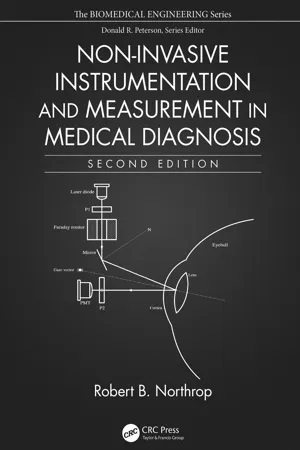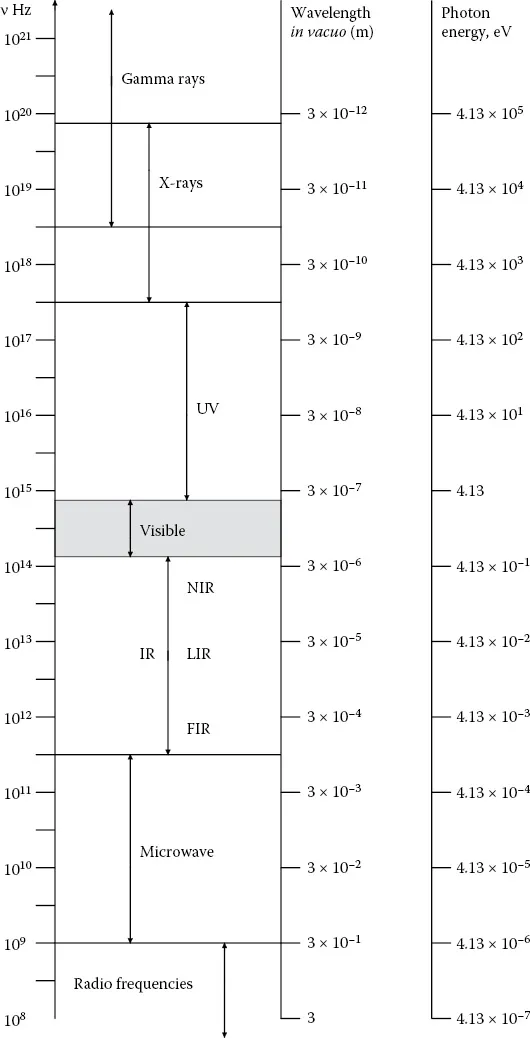![]()
1Introduction to Noninvasive Medical Measurements
1.1Definitions of Noninvasive, Minimally Invasive, and Invasive Medical Measurements
In this chapter, let us attempt to reach consensus about what we mean by noninvasive (NI) medical measurements. Any measurement system that does not physically breach the skin, or enter the body deeply through an external orifice is truly NI. Thus, the measurement of body temperature with a thermometer in the mouth, rectum, or ear canal is considered NI, as is the use of an otoscope to examine the outer surface of the eardrum. Similarly, the use of the ophthalmoscope and slit lamp which shine light in the eyes to examine the retina and the cornea and lens, respectively, is considered NI procedures. The transduction of sounds from the body surface (from the heart, breath, otoacoustic emissions, joint sounds, etc.) is truly NI, as is the recording of electric potentials on the skin from internal sources such as the heart (ECG), skeletal muscles (EMG), brain (EEG), etc. Medical imaging techniques such as x-ray, x-ray tomography (CAT scan), ultrasound, magnetic resonance imaging (MRI), positron emission tomography (PET), etc. are NI; they do involve the input of energetic radiation into the body, however, which generally carries low risk when proper energy levels and doses are observed.
Much can be learned from blood samples; namely, ion concentrations, red blood cell density, white blood cell density, the concentrations of certain hormones, antibodies, cholesterol, drug concentrations, DNA type, pathogens, chemical indicators of chronic diseases, etc. The drawing of small blood sample, say <1 cm3, from a superficial vein by a needle and syringe or a lancet is considered to be a minimally invasive procedure, requiring sterile technique.
Endoscopy is a technique for visualizing tissues deep within the body yet topologically on the outer surface of the body. An example is bronchoscopy, where a bronchoscope is inserted through the mouth and larynx, into the trachea and bronchial tubes of the lungs to permit visualization of their surfaces and the surfaces inside larger alveoli. Another endoscope is the cystoscope which is inserted into the urethra to inspect the ureter, the prostate, and the inside of the bladder. Many other types also exist (Section 2.3). As a rule, endoscopes require sterile technique, and in most cases, local or general anesthesia; I consider them to be moderately invasive instruments, and endoscopies moderately invasive procedures.
Some endoscopes are used invasively, such as laparoscopes, which are inserted into the abdomen through a small incision in the wall of the abdomen, chest, or back. They are used to examine the outsides of the internal organs (bladder, gall bladder, intestines, kidneys, liver, lungs, spine, spleen, uterus, etc.) for tumors, infections, damage from trauma, etc. Another invasive procedure, for example, is cardiac catheterization with a fiber optic endoscope in order to view heart valves.
One can argue that there are fuzzy classification boundaries separating NI, minimally invasive, moderately invasive, and invasive diagnostic procedures. Anyone who has undergone a colonoscopy or proctoscopy may be quick to argue that they are more invasive than minimally invasive diagnostic procedures, considering the preparation, medication (analgesia or anesthesia), and discomfort involved. Thus, we argue that invasiveness should be assessed on a four-level (two-bit) scale, that is, levels 0–3.
This text is about the instruments and measurement systems used in making modern, non-invasive medical diagnoses (NIMDs). Some of the instruments and systems described are well-established, Food and Drug Administration (FDA)-approved systems; others are prototype systems that eventually may prove safe, medically and cost-effective. It is important for the reader to know where the field of NI diagnostic instrumentation is headed, as well as its present status. Its evolution is rapid, fueled by the advances in information processing and storage, as well as in the fields including photonics, molecular biology, and medical physics.
Throughout the history of medicine, up to the end of the nineteenth century, most medical diagnoses were necessarily NI. The physician used his or her eyes to observe skin lesions, and inflammation in the nose, throat, gums, ears, and skin. Tactile senses in the physician’s hands were used to feel skin temperature, edema, swelling due to infection, lumps under the skin, etc. The physician’s ear was used to listen to breath, bowel, and heart sounds. The odors of infection was sensed by the physician’s nose. Exploratory surgery was seldom done because of the risk of shock due to pain and blood loss, and danger of infection.
Today, considerable emphasis is on the use of NI diagnosis in health maintenance and emergency medicine. Most of it can be carried out on an outpatient basis, and carries little risk of infection or complications which would add to the cost the patient’s health maintenance organization (HMO) must pay. On the other hand, certain NI instruments, such as the various medical imaging systems, are very expensive to build and maintain and their use fee is commensurately large. Indeed, NI diagnostic procedures, including imaging systems, have been accused of driving up the cost of health maintenance and care. The effective but simple NI, level 0 instruments such as the electrocardiograph, the spirometer, and the slit lamp and their use certainly are not culprits in this respect. The advantage of being able to see tumors in the middle of soft tissues such as the brain, lungs, liver, spleen, and breasts will continue to drive the need to improve the resolution of expensive imaging systems, and to ensure their use where indicated.
![]()
1.2Modalities of NI Instrumentation
NI medical instruments can be broadly classified between those passive systems that put no energy into the body, and those that input some form of radiation energy, for example, microwaves, visible and UV light, x-rays, γ-rays, sound and ultrasound, and measure what energy is either absorbed, reflected, or transmitted at different wavelengths or frequencies. Among the purely passive systems, we have the well-known electrical measurements based on active nerve and/or muscle membranes. These include time-varying electrical potentials recorded from the skin surface from the heart (ECG), brain (EEG), muscles (EMG), ears (electrocochleogram [ECocG]), and eyes (EOG and ERG). Sounds from the body’s interior can also be recorded from the skin surface, including sounds from the heart valves, pericardium (friction rub), blood vessels (bruit), lungs, bronchial system, pleural cavity, eardrums (spontaneous otoacoustic emissions), joints, etc. Body temperature can be sensed from the infrared radiation from the eardrum, or by physically measuring the temperature of the saliva and tissues under the tongue, or the temperature in the rectum by a liquid-in-glass thermometer, or a thermometer based on a thermistor or platinum resistance element (resistance temperature detector [RTD]). Tissue oxygen and carbon dioxide partial pressures (pO2 and pCO2) can be measured transcutaneously with special chemical electrodes. The only energy put in by endoscopes is white light required to visualize or photograph the tissue being inspected. Blood pressure can be measured noninvasively by Korotkoff sounds emitted by the brachial artery as the pneumatic pressure in a sphygmomanometer cuff is slowly reduced, allowing blood to surge into an artery.
Just about every other physiological modality that can be measured noninvasively requires some small input of energy. An important class of NI imaging systems uses pulsed ultrasonic energy. The energy level of the input ultrasound is made low enough to avoid tissue-destroying cavitation or heating. Other NI, nonimaging, diagnostic systems that use continuous-wave (CW) ultrasound include Doppler blood velocity probes and Doppler probes used to sense the fetal heartbeat or detect aneurisms.
Electromagnetic radiation includes radio-frequency electromagnetic waves, THz waves, infrared (IR), visible, and ultraviolet, as well as x-rays and gamma rays (Figure 1.1). The photons from UV radiation, x-, and gamma rays have sufficient photon energy (hν) to knock atomic electrons out of their inner orbits and rupture certain molecular bonds, causing DNA mutations, etc.; UVB, x-, and gamma rays are called ionizing radiations because of the potential destruction they can cause to biomolecules as the result of ionization of water and other molecules. Thus, the use of NI instruments that emit ionizing radiation is not without some small health risk. UVB photons do not penetrate the skin deeply; hence, UV damage to skin can include reddening (burns) and the initiation of various types of skin cancers. The corneas and lenses of eyes given excessive UVB radiation can develop cataracts. X- and gamma ray photons, on the other hand, can penetrate the body deeply, causing cell damage in the organs. A high-energy x-ray photon can directly damage a DNA molecule, leading to a cellular mutation if not internally repaired by the cell. If a photon-dislodged electron strikes a water molecule, it can create a free radical. The estimated lifetime of a free radical is ∼10 µs, which means it can drift and encounter a DNA molecule, producing indirect damage as stable molecular configurations are restored. Note that we are mostly concerned with electromagnetic ionizing radiations in this text. Certain radioisotopes used in medical imaging and in cancer therapy emit energetic alpha particles (He nuclei), beta particles (electrons), or neutrons. These energetic particles can also generate free radicals and cause DNA damage, and initiate cell death by apoptosis.
Figure 1.1Electromagnetic spectrum ranges that find application in medical diagnosis. Photon energies in electron volts at a given wavelength are given in the right-hand column.
X-ray machines of all sorts, bone densitometers, and CAT and PET scanners thus carry a small risk of inducing cancer, including leukemia, in the patient. However, most healthy persons absorb far more ionizing radiation in the form of 5.5 MeV alpha particles from the radioactive breakdown of inhaled, naturally occurring, radon gas (e.g., 222Rn) than they do from x-rays. Note that 36 radioisotopes of 222Rn have been characterized, with atomic masses ranging from 193 to 228. 210Pb is formed from the decay of 222Rn.
Other NI instrumentation systems such as impedance plethysmographs, pass low levels (in the microamp range) of alternating current (AC) in the frequency range from 25 to 100 kHz through the tissues being studied. The input of this current is apparently without risk; it is way...

